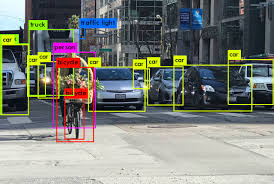Several techniques can be employed for object recognition. These range from traditional methods to advanced deep learning approaches. Each technique has its own advantages. It is suited to specific applications.
Template Matching
Template matching is one of the simplest object recognition techniques. It involves comparing segments of an image to predefined templates of objects. This method works well for detecting objects with fixed shapes and appearances but is limited in handling variations in scale, orientation, and lighting conditions.
Feature-Based Methods
Feature-based methods involve extracting distinctive features from images, such as edges, corners, and textures. These features are then used to match objects within an image. Popular feature-based algorithms include Scale-Invariant Feature Transform (SIFT) and Speeded-Up Robust Features (SURF). These methods are more robust than template matching but still face challenges with significant variations in object appearance.
Machine Learning Approaches
Machine learning techniques, such as Support Vector Machines (SVM) and Random Forests, have been applied to object recognition. These approaches involve training classifiers on labeled datasets to recognize different object categories. While effective, traditional machine learning methods often require extensive feature engineering and may struggle with complex objects and backgrounds.
Deep Learning Techniques
Deep learning has revolutionized object recognition with its ability to automatically learn hierarchical features from data. Convolutional Neural Networks (CNNs) are the most widely used deep learning models for object recognition. CNNs consist of multiple layers that learn to detect features at different levels of abstraction, from simple edges to complex patterns. This enables them to achieve state-of-the-art performance in various object recognition tasks.
Transfer Learning
Transfer learning is a technique where a pre-trained model, usually a deep neural network, is fine-tuned on a specific task or dataset. This approach leverages the knowledge learned from a large dataset, such as ImageNet, to improve performance on smaller datasets. Transfer learning is particularly useful when labeled data is scarce, reducing the need for extensive training.
Applications in Self-Driving Cars
Object recognition plays a vital role in the development of autonomous vehicles, enabling them to perceive and interpret their surroundings accurately. Self-driving cars rely on a combination of sensors, including cameras, LiDAR, and radar, to gather information about the environment. Object recognition algorithms process this data to identify and track various objects, such as pedestrians, vehicles, traffic signs, and road markings.
Pedestrian Detection
Detecting pedestrians is crucial for ensuring the safety of self-driving cars. Advanced object recognition models can identify pedestrians in various poses and lighting conditions, allowing the vehicle to take appropriate actions, such as slowing down or stopping. CNN-based models, such as Faster R-CNN and YOLO (You Only Look Once), have demonstrated high accuracy in pedestrian detection tasks.
Vehicle Recognition
Accurate recognition of other vehicles on the road is essential for collision avoidance and navigation. Object recognition systems can identify different types of vehicles, including cars, trucks, and motorcycles, and estimate their positions and velocities. This information helps the autonomous vehicle make real-time decisions to maintain safe distances and execute lane changes.
Traffic Sign Recognition
Traffic sign recognition is critical for obeying traffic rules and ensuring smooth navigation. Object recognition models can detect and classify various traffic signs, such as stop signs, speed limits, and yield signs. This capability enables self-driving cars to adapt to changing road conditions and follow traffic regulations.
Applications in Surveillance
Surveillance systems rely heavily on object recognition to monitor and analyze activities within a monitored area. Object recognition enhances the capabilities of surveillance systems, enabling them to detect suspicious behavior, track individuals, and identify potential threats.
Intrusion Detection
Object recognition algorithms can detect unauthorized individuals entering restricted areas. By analyzing video feeds in real-time, surveillance systems can trigger alarms and notify security personnel when intrusions are detected. This helps in preventing security breaches and ensuring the safety of sensitive locations.
Face Recognition
Face recognition is a specialized form of object recognition used in surveillance for identifying individuals. Deep learning models, such as DeepFace and FaceNet, have achieved remarkable accuracy in recognizing faces from images and videos. This technology is widely used in access control systems, law enforcement, and public safety applications.
Crowd Monitoring
Object recognition can be employed to monitor and analyze crowd behavior in public places. By identifying and tracking individuals within a crowd, surveillance systems can detect anomalies, such as sudden gatherings or suspicious movements. This information is valuable for maintaining public order and preventing potential threats.
Challenges and Future Directions
While object recognition has made significant strides, several challenges remain. Handling variations in lighting, occlusions, and object appearances can be difficult. Additionally, real-time processing requirements and the need for large labeled datasets pose further challenges.
The future of object recognition lies in developing more robust models that can generalize well across diverse environments. Advancements in deep learning, coupled with the integration of multimodal sensor data, will continue to drive progress in this field. Furthermore, ethical considerations, such as privacy concerns and bias mitigation, will play a crucial role in shaping the future of object recognition technologies.
Conclusion
Object recognition is a cornerstone of computer vision, enabling machines to interpret visual data and make informed decisions. Its applications in self-driving cars and surveillance systems demonstrate its transformative potential in enhancing safety, security, and efficiency. As technology continues to evolve, object recognition will play an increasingly vital role in shaping the future of autonomous systems and intelligent surveillance solutions. By addressing current challenges and leveraging advancements in deep learning, we can unlock new possibilities and create a safer and more connected world.
